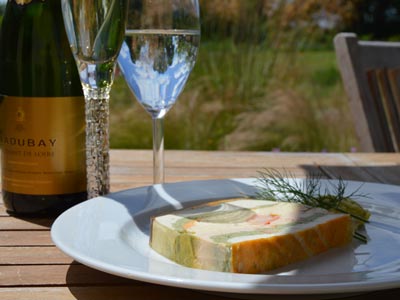Prieure de Saint-Cosme
The priory of Saint Cosme was, according to the 12th century canons, “heaven on earth that prepared the way to true paradise” – “a heaven on earth that eased the journey to the real heaven.”
Originally on a fishery site, the first Monastery was built on a small island of the Loire river, around a small church, La Chapelle Saint Come, founded by Herve de Buzancais.
In 1092 a larger new church and a new cloister were built by a community of Regular St Augustine Canons.
In 1187, King Henry II of England, in whose dominions of his Angevin Empire (L’Empire Plantagenet) the Priory was at the time, allowed it to be used as a refuge for the exiled Archbishop of Trier, Folmar of Karden.
Ransacked by the Huguenots in 1563, the priory saw its defences strengthened under the Priorats of Charles de Ronsard and his brother, Pierre de Ronsard, a French poet, known as “Prince of Poets”. In 1565 Queen Catherine de Medici appointed him head of the priory of Saint Cosme, which became one of the poet’s favourite places of inspiration. He died in December 1585 and was buried inside the church.
After a prosperous time until then, in 18th century Priory of Saint Cosme, like many other monastic institutions, faced financial problems, and was permanently removed in 1742.The monks gathered together in Saint Martin of Tours.
During the French Revolution. The priory was confiscated and sold as national property. In 19th century it became a kind of a village with 17 families, who for the most part, lived off the land.
In May and June 1944, the priory was a victim of heavy Allied bombing targeting the nearby railway bridge.
In 1951, the priory became property of Indre-et-Loire and reopened to the public thanks to a donation made by the Sauvegarde de l’Art Francais. The new association Amis de Ronsard et du Prieure was founded and worked to revive the area and the gardens.
The Gardens of The Prieure de Saint-Cosme.
As a result of archaeological excavations between 2009 and 2013, the gardens were recreated.
In 2015, new gardens and a unique scenic tour became available to the public.
The new gardens highlight the architectural structure of the priory and blend in with a natural setting. They were created with an idea to present daily life in monastery which was home to a poet Pierre de Ronsard during the Renaissance period, using a contemporary filter.
The result encourages the visitor to walk around and experience the unique character of this magnificent space.










